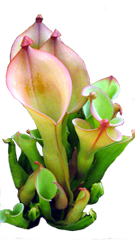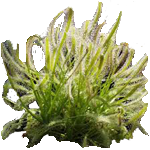The Venus flytrap (Dionaea muscipula)
The Venus flytrap is perhaps one of the best-known and most awesome plants. Its leaves are modified in an extraordinary way in order to feed on insects, although it does still obtain energy from the sun. The plant is an innocuous looking rosette, but the leaf blades terminate in distinctive bivalve traps with sharply toothed edges. The outside of the traps is generally green while the insides have red pigment that varies in shade depending on the age of the trap; on the edge of each lobe there are 14-20 teeth that point radially from the trap. The flower stalk is devoid of leaves (known as a scape) and can reach up to 30 cm tall. In season, small white flowers are born with faint green veins; the seed capsules are flat and contain a single, shiny black seed.This information came from. www.arkive.org
For information on the care of this plant go to
Fly Trap Care

The Round-leaved Sundew (Drosera rotundifolia)
The Round-leafed Sundew is a strange and beautiful plant that can be found sitting among the soggy Sphagnum mosses at the shores of bog pools, on wet heaths, and peaty moors. This acidic habitats doesn't provide enough nutrients for the plant, so the plant has evolved to this carnivorous way of life to supplement its diet. This sundew is a tiny, slender plant, that has on each leaf, hair-like tendrils tipped with glistening droplets attract passing insects. But this 'dew' is very sticky, and as bug moves on the leave the sundew's tendrils detect the presence of prey on its leave, the leave starts wrapping the leave inwards around the insect trapping it. Eventually, the whole leaf wraps around the prey. The enclosed insect is digested and the nutrients are absorbed by the plant. This information came from. awww.thewildlifetrust.org
For information on the care of this plant go to
The Round-leaved Sundew

Heliamphora chimantensis
plants are from Guayana, southern Venezuela, and northern Brazil. The sandstone table topped mountains were they grow are known as "tepuis". These mountains are six to eight thousand feet above sea level were they disappear into the clouds. The Heliamphora are the most primitive carnivorous plants. The trap looks like a leaf that is rolled into a funnel, joined by a seam in the front. At this seam, the pitcher is about a 1/4" lower then the rest of the trap. Excess water can run out of the trap while leaving any caught insects. Heliamphora lure insects to the trap by a small bell shaped, nectar spoon, which is attached to the back of the pitcher and hangs over the pitcher opening. This information came from.http://mysite.verizon.net/
For information on the care of this plant go to.
heliamphora

The Green Pitcher Plant (Sarracenia oreophila)
The Green Pitcher Plant is a carnivorous plant with highly modified leaves in the form of pitchers that act as pitfall traps for prey. The narrow pitcher leaves are tapered tubes that rise up to 75 centimetres from the ground, with a mouth 6 to 10 centimetres in circumference. The pitchers are greenish-yellow with noticeable fine veins, and above the pitcher a circular hood extends at an angle of roughly 180° upwards. The inside of the pitcher is hairy and heavily marked with purple veins. The leafless flower stalk grows to two-thirds the height of the pitchers. This information came from.http://www.arkive.org/
For information on the care of this plant go to
The Green Pitcher Plant

Thread-leaved sundew (Drosera filiformis)
The Thread-leave sundew is a striking member of the sundew family with it's distinctive, stringy leaves covered with glistening droplets of sticky exudate. Insects trapped in the sticky hairs are digested by plant enzymes. Researchers have found that substantial quantities of protein from the insects end up in the storage roots, demonstrating the importance of this source of nutrients. The southern plants are larger than the northern and are considered by some authorities to be the separate species D. tracyi. The genus name derives from the Greek droseros (dewy) and refers to the sticky droplets on the leaves. This information came from.http://www.wildflower.org/
For information on the care of this plant go to
Drosera filiformis
